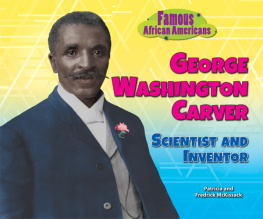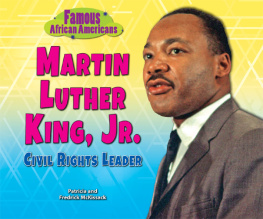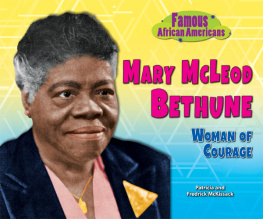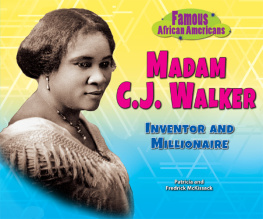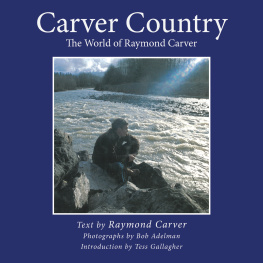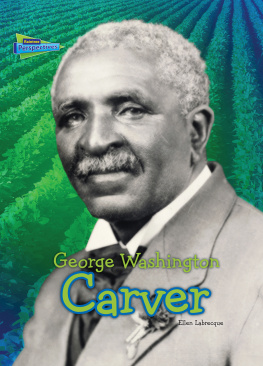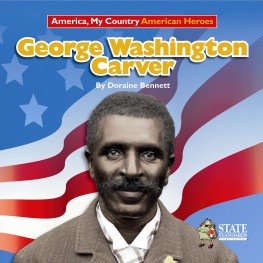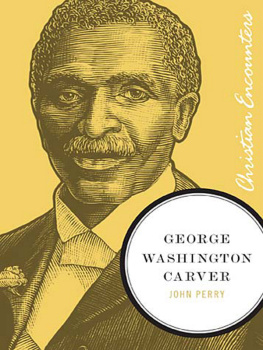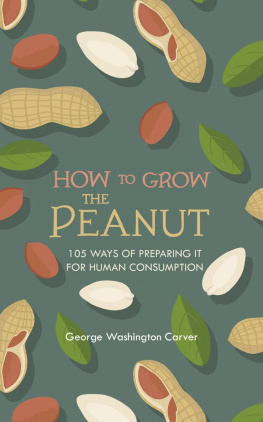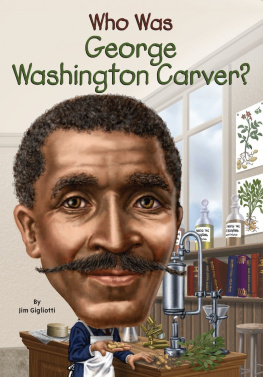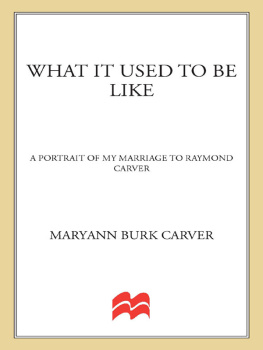THE WIZARD OF TUSKEGEE
BORN A SLAVE, GEORGE WASHINGTON CARVER WANTED NOTHING MORE THAN TO GO TO SC HOOL AND LEARN. HE WORKED HARD TO PAY FOR SC HOOL AND STUDIED PLANTS AND FARMING IN COLLEGE. HIS FARMING IDEAS ARE STILL USED TODAY, AND HE IS THE REASON PEANUTS ARE SO POPULAR. READ ABOUT CARVERS LIFE IN THE FAMOUS AFRICAN AMERICANS SERIES.
ABOUT THE AUTHORS

Patricia and Fredrick McKissack have written over one hundred books about the African-American experience. They have won countless awardsincluding the Coretta Scott King Awardand received much critical acclaim, all the while bringing enjoyment and information to young readers.

Image Credit: Library of Congress
George Washington Carver was born a slave.
Moses and Susan Carver owned a small farm in Diamond Grove, Missouri. They owned one slave, Mary. She had two small children, James and George.
One day a neighbor came to warn the Carvers. Slave raiders were in the area. Slave raiders stole slaves and sold them again.
The raiders came late that night. They stole Mary and baby George and then rode away.
Moses Carver went after them. He found baby George by the side of the road. He never found Mary.
The Carvers had no children. So they raised James and George as their own. The boys called the Carvers Aunt Susan and Uncle Moses.
George was a sickly boy. His voice was thin and weak. He stuttered sometimes when he spoke in a hurry. But he was a happy child who loved plants and animals.
Aunt Susan taught him to read and write. She gave him a Bible. He loved his Bible very much.The boy was always full of questions. He wanted to learn about everything. But the only school for black children was miles away.
It was too far for a little boy to walk each day. George had to wait.

Image Credit: Ned O.
George spent his childhood on a farm. He loved to be around animals and plants.

Image Credit: Ned O.
There were no schools for George where he lived. He left home so he could go to school.
When George was about twelve years old, he left the Carvers. He wanted to go to school. He walked to Neosho, Missouri. A family found George sleeping in their barn. They let the boy live with them. George worked and went to Lincoln School.
A few years passed. George learned all he could at Lincoln. He heard about a school in Fort Scott, Kansas. So he moved there. Another family let George live with them. Soon, young Carver was old enough to live on his own. For a while he moved from place to place.
Then he came to a small Kansas town. Another man named George Carver lived there. So George added a W to his name. It is for Washington, he told his friends. George Washington Carverhe liked the sound of his new name.

Image Credit: Library of Congress
George (front right) wanted to be an artist when he was a young man. He studied art at school.
George wanted to go to college. Not many black men went to college in the 1890s. But George Carver was sure that he would go. He worked hard and saved his money.
At last Carver went to college in Iowa. There he studied what he liked bestplants and farming. Then he went to Iowa State College in Ames to study. He graduated in 1896. Still, there was much more he wanted to learn.
George Washington Carver would spend the rest of his life asking questions and looking for the answers. He was a scientist. And scientists are always asking Why? and How?
George Carver was asked to stay at Iowa State and teach. But Booker T. Washington asked Professor Carver to come teach at Tuskegee Institute in Alabama.
The all black school was started by Booker T. Washington in 1881. In 1896, Mr. Washington wrote a letter to Professor Carver: Will you come to Tuskegee to teach? Carver thought about it. Then he answered: I am coming.
It was fall 1896 when Professor Carver went to Tuskegee. He had thirteen students. His job was to teach science. But he had no lab. This didnt stop him. The class made a lab from things they found.

Image Credit: Library of Congress
The students at Tuskegee helped to build their own lab.

Image Credit: Ned O.
Professor Carver taught his students about farming. He had many new ideas about how to grow crops.
The school also had a farm. The soil was poor. The cotton plants were small and weak. Farmers in the South had been growing cotton on the land for many years. Professor Carver said, The soil needs a rest. He and the class did a project. We will not plant cotton, he said. We will plant sweet potatoes. And they did.
The next year they grew cowpeas, another kind of vegetable. The land has to rest, he said.
So the third year they grew cotton again. That cotton crop grew bigger and stronger than before. Carver was one of the first scientists to teach crop rotationgrowing different plants to make the soil better.
The boll weevil is a bug that eats cotton plants. In the early 1900s, boll weevils came into the United States from Mexico. Farmers were worried. What could they do? Carver told them to plant goobers! Boll weevils dont like goobers.

Image Credit: Ned O.
Professor Carver invited a group of businessmen to dinner. He wanted to show them the many uses of peanuts.
Goobers!
Goober is an old African name for peanut. Slaves brought goobers from Africa. They grew them in small gardens. Goobers were mostly used to feed animals.
Farmers came to Tuskegee from all over the South. Professor Carver told them about his work. What can be done with peanuts? They are only good for hogs, people said. Carver found many ways to use peanuts. His students liked peanut butter best.
Who will buy the peanuts? Professor Carver didnt know. But, as always, he kept looking for answers.
Then an idea came. The quiet professor asked a group of important businessmen to have dinner with him. He served them bread, soup, meat, cookies, and ice cream.

